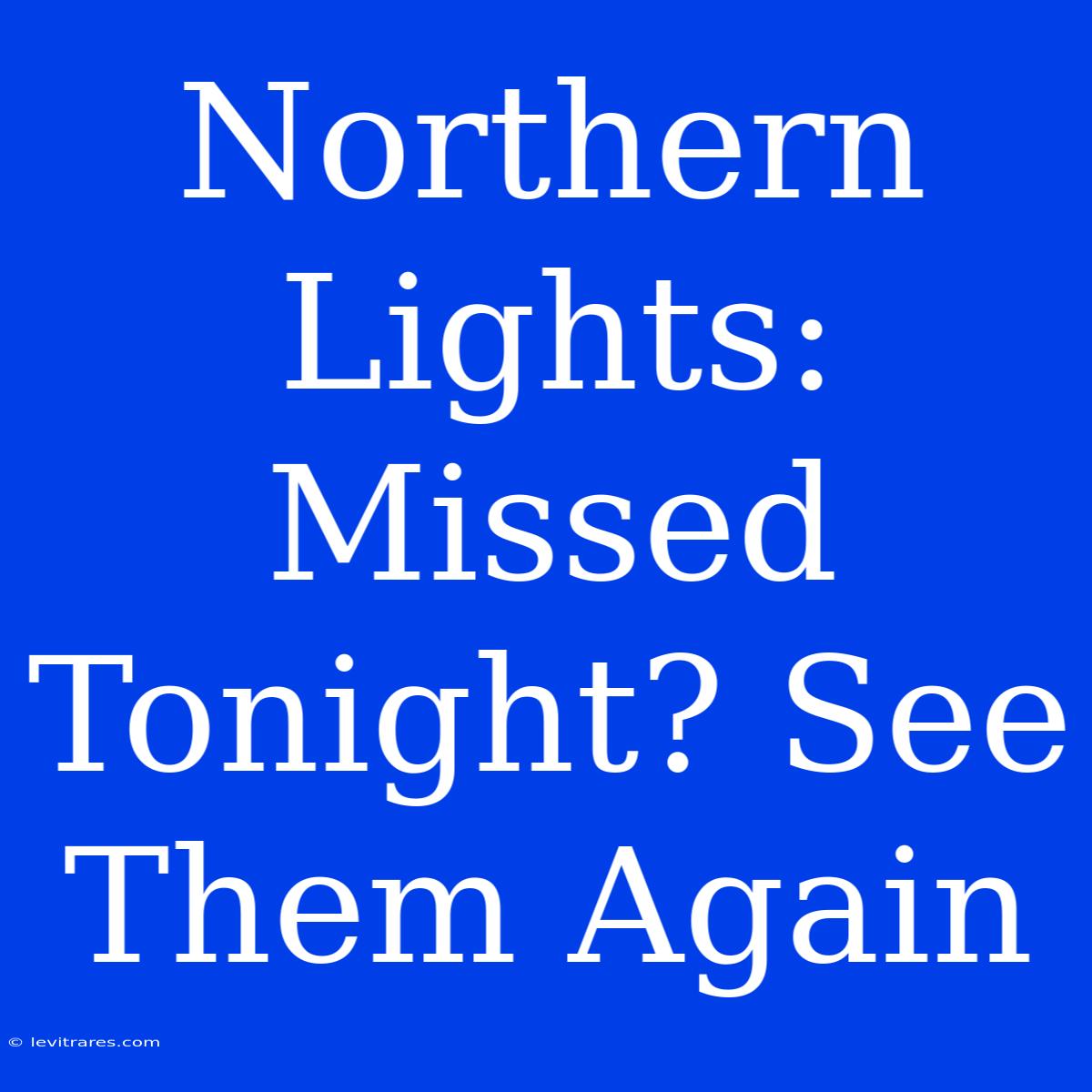Northern Lights: Missed Tonight? See Them Again!
Are you yearning to witness the celestial spectacle of the Northern Lights, but missed your chance tonight? Don't despair! The ethereal dance of light across the sky can be seen again, and we're here to help you catch the show.
Editor Note: The Northern Lights, also known as Aurora Borealis, are a captivating natural phenomenon that draws visitors from around the world. Understanding the science behind them and knowing the best places and times to view them is crucial for maximizing your chances of witnessing this breathtaking display.
Why is this topic important? Witnessing the Northern Lights is a bucket list item for many travelers, and understanding the conditions that influence their appearance is essential for planning a successful viewing trip. This article provides insights into the science behind the Aurora Borealis, the best locations for viewing, and tips for capturing the perfect photograph.
Our analysis: We've delved into the scientific research on the Northern Lights, explored expert opinions on the best viewing locations, and compiled a comprehensive guide for capturing the Aurora on camera. This article draws on data from NASA, NOAA, and leading aurora photographers to provide a well-rounded and accurate understanding of this captivating natural phenomenon.
Key Takeaways about the Northern Lights:
| Key Aspect | Description |
|---|---|
| Solar Activity | The intensity of the aurora is directly influenced by the sun's activity. |
| Geomagnetic Storms | These storms can create spectacular displays of the aurora, but also pose risks to satellites. |
| Viewing Locations | The Northern Lights are most visible in high-latitude regions like Alaska, Canada, and Scandinavia. |
| Best Time to View | Autumn and Winter, during periods of high solar activity, offer optimal viewing conditions. |
| Clear Skies | Unclouded skies are essential for observing the aurora, making clear nights ideal. |
| Photography Tips | Long exposures, wide-angle lenses, and dark skies enhance the capture of the aurora. |
Northern Lights: An Illuminating Guide
1. Understanding the Aurora Borealis
The Northern Lights are a captivating display of light in the sky, primarily seen in the high northern latitudes. This natural phenomenon occurs when charged particles from the sun, known as the solar wind, interact with Earth's atmosphere. The sun emits a constant stream of solar wind, and when this wind interacts with Earth's magnetic field, it creates a stunning visual display.
2. Optimal Viewing Locations
The Northern Lights are most visible in regions close to the Earth's magnetic poles, specifically in the northern hemisphere. Alaska, Canada, Norway, Iceland, Sweden, Finland, and Greenland offer prime locations for viewing.
3. Planning Your Trip
Timing: The best time to view the Northern Lights is during the winter months, when the nights are long and dark. The peak season typically runs from September to April.
Solar Activity: It's essential to check the current solar activity levels to increase your chances of seeing the aurora. Websites like Spaceweather.com provide real-time data on solar storms and aurora forecasts.
Clear Skies: As with any celestial observation, clear skies are essential for viewing the Northern Lights. Check the local weather forecast before heading out.
4. Capture the Aurora on Camera
Camera Settings: Use a DSLR or mirrorless camera with a wide-angle lens, a tripod for stability, and long exposures to capture the vibrant colors of the aurora.
Focusing: Manual focusing is recommended, as auto-focus might struggle in low light conditions. Focus on a distant object for a sharp image.
White Balance: Adjust the white balance to a colder temperature, often labeled as "fluorescent" or "daylight," to enhance the aurora's colors.
ISO Sensitivity: Higher ISO settings increase light sensitivity but can introduce noise. Find the optimal balance between noise and brightness.
FAQ: Northern Lights
Q: How often do the Northern Lights appear? A: The aurora is a continuous phenomenon, but its visibility varies depending on solar activity and weather conditions.
Q: Are the Northern Lights visible everywhere? A: While the aurora is constantly active, it's primarily visible in high-latitude regions.
Q: What is the best way to predict the Northern Lights? A: Websites like Spaceweather.com and aurora forecasting apps provide real-time data on solar activity and aurora intensity.
Q: Can I see the Northern Lights in the daytime? A: The aurora is primarily visible at night, when the sky is dark enough for the colors to be seen.
Q: What if I miss seeing the Northern Lights tonight? A: With a little planning and an understanding of the factors influencing the aurora, you can increase your chances of witnessing this spectacular celestial display.
Tips for Viewing and Capturing the Northern Lights
- Choose a dark location: Avoid light pollution from cities or towns.
- Dress warmly: Nights in high-latitude regions can be frigid.
- Be patient: The aurora can be unpredictable.
- Use a red-light headlamp: Red light doesn't interfere with night vision.
- Experiment with different camera settings: Find the settings that best capture the beauty of the aurora.
Northern Lights: A Conclusion
Witnessing the Northern Lights is an unforgettable experience that leaves a lasting impression. With an understanding of the science behind the aurora, planning your trip carefully, and following these tips, you can increase your chances of seeing this mesmerizing natural wonder. Remember, patience and a little bit of luck can make the difference between a memorable night and a truly awe-inspiring experience.

